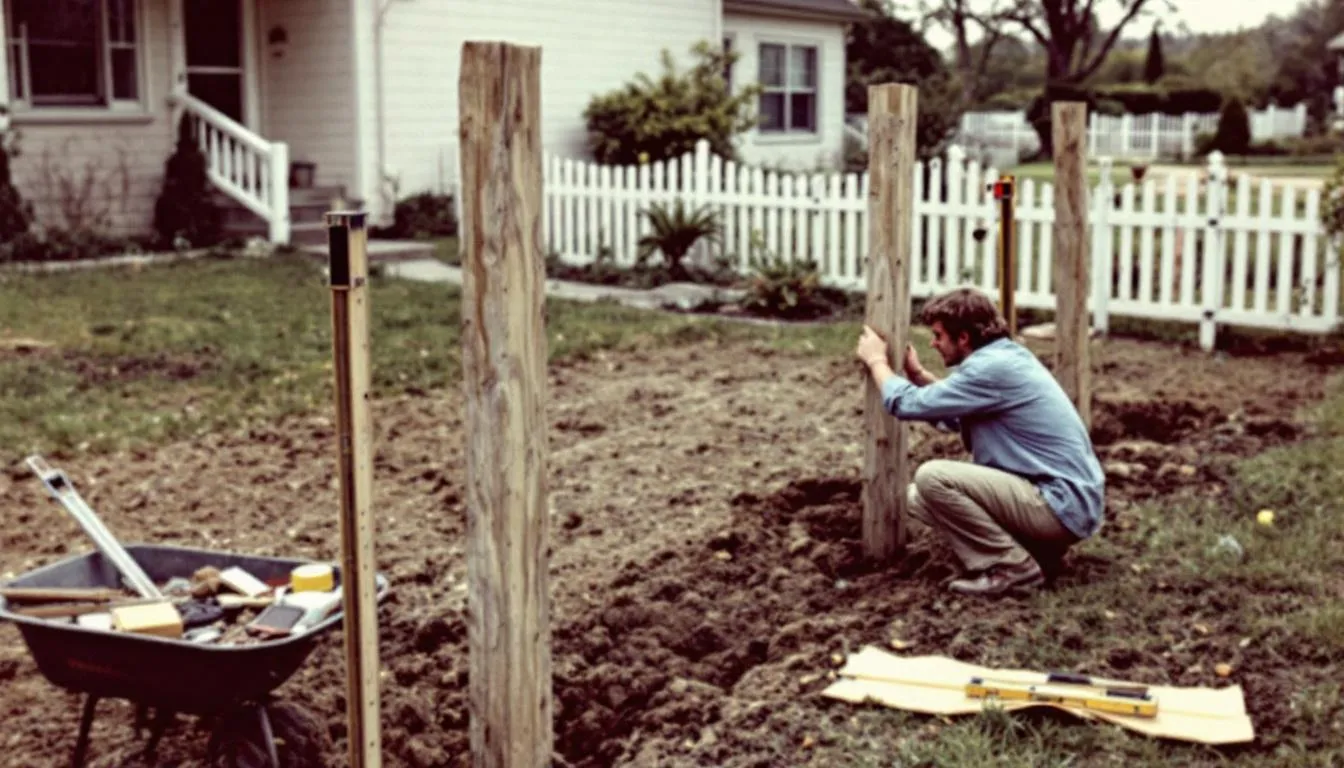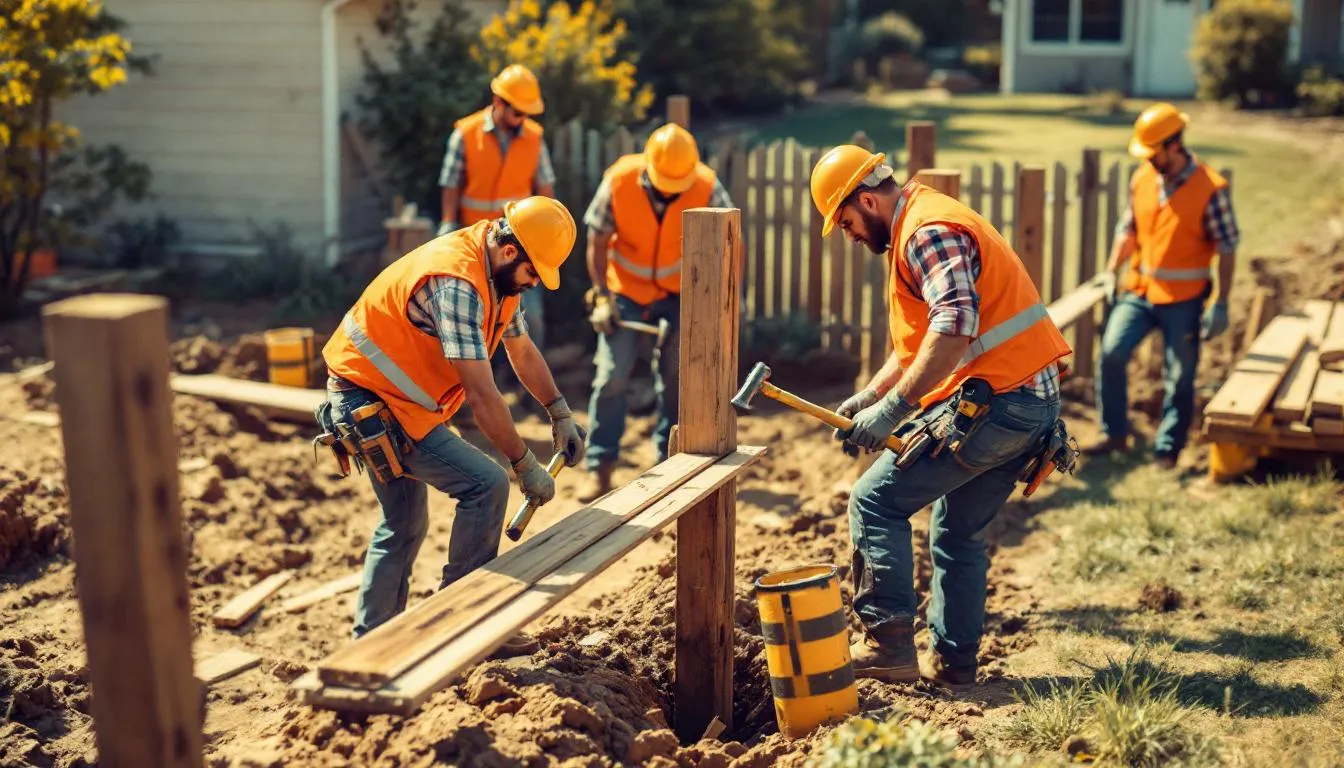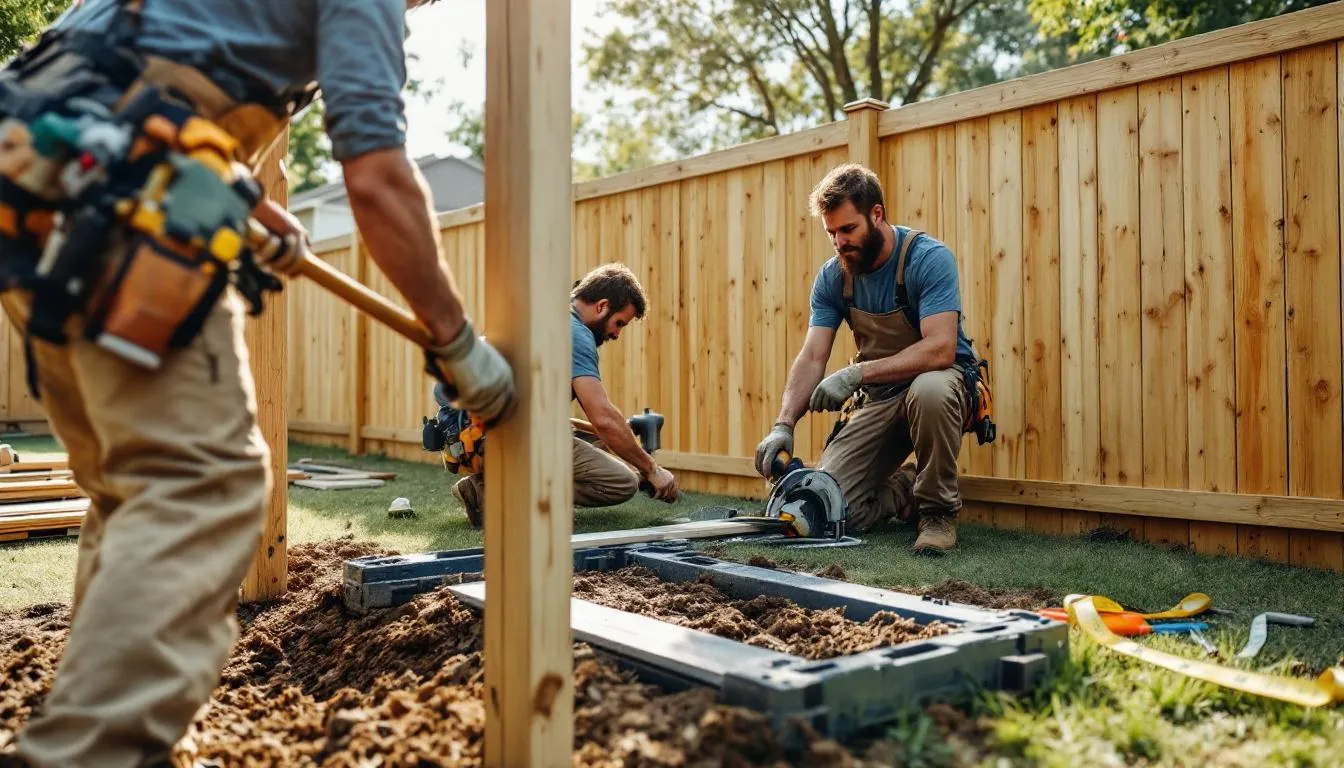Need help with fence installation? This guide covers everything you need to make your fence installation simple and efficient, from choosing a contractor, handling permits, to preparing your property for installation fences. Let’s dive in and make your fence project hassle-free.
Key Takeaways
-
Choosing the right fence contractor is essential for a smooth installation—research, read reviews, and compare estimates.
-
A clear and detailed fence installation contract prevents misunderstandings and outlines costs, timelines, and responsibilities.
-
Proper property preparation and understanding local building codes are crucial steps to avoid delays and ensure compliance during installation.
Choosing the Right Fence Contractor

Selecting the right fence contractor is the cornerstone of a smooth fence installation. Start by:
-
Doing thorough research and reading customer reviews to get insights into a contractor’s past performance and customer satisfaction.
-
Not settling for the first contractor you find.
-
Obtaining multiple estimates to compare prices and services, ensuring you get the best fit for your project.
It’s also crucial to verify that the contractor is licensed and insured. This demonstrates their legitimacy and adherence to safety standards, ultimately protecting you as the homeowner. A licensed and insured contractor is more likely to follow industry standards and provide a quality installation, minimizing future issues.
Remember, the right contractor can make all the difference in the world. They will not only deliver a quality fence but also provide peace of mind throughout the installation process. So take your time, do your research, and choose wisely.
Understanding Your Fence Installation Contract
A well-drafted contract helps prevent misunderstandings and ensures a smooth fence installation process. The contract should clearly identify both the homeowner and the fence contractor, including their names and contact details, and should also include a sign. This ensures that all parties are on the same page and can easily communicate if any issues arise.
The scope of work in the contract must specify the type of fence, materials, dimensions, and any additional features. This level of detail helps to avoid any confusion about what is included in the project. Additionally, the contract should outline total project costs, payment milestones, and clarify payment methods and due dates. This transparency will help you manage your budget effectively and avoid any unexpected costs.
Finally, it’s vital to establish a realistic timeline for the project, including the anticipated start and completion dates. This ensures that you and the contractor have a clear understanding of the project duration, helping to avoid any unnecessary delays.
Preparing Your Property for Fence Installation

Preparing your property correctly ensures a smooth fence installation process. Start by clearing the installation area and marking underground utility lines to avoid any damage during the digging process. This step is often overlooked but can save you from costly repairs and delays.
Plants or shrubs located near the fence line should be tied back to avoid damage during the installation process. Additionally, have a plan for managing the dirt that results from digging post holes. This dirt can be displaced and should be placed in sensible areas like wooded regions or leveled out spots.
Proper preparation ensures that the access installation process is efficient and minimizes disruptions to your property with integrity upon request in business. This job is crucial for maintaining quality ahead and has been installed correctly.
Navigating Local Building Codes and Permits
Understanding local building code and permits is a crucial step in the fence installation process. In many areas, including New Jersey, a permit is required for fence installation. If you’re unsure about the permit process, contact the building or zoning department. Starting the permit application process early can help you avoid delays and ensure your project stays on schedule.
Key points regarding fence regulations and property lines include:
-
Additional documentation, like site plans or surveys, is typically required for fences taller than 6 feet, which relates to fence height.
-
Misjudging property lines can lead to disputes, so it’s essential to verify your property lines through surveys.
-
Not adhering to local regulations can result in fines or the removal of the fence.
-
Experienced fencing companies are familiar with local regulations and can ensure compliance with city laws, saving you time and hassle.
If you share a property line with a neighbor, it’s a good idea to inform them about the planned fence installation to avoid misunderstandings. The contract should also clarify who is responsible for obtaining necessary permits and any related costs.
Accurate Quote and Budget Planning
Accurate quotes and budget planning ensure a successful fence installation project. Start by gathering crucial details about your property, such as property lines and existing landscaping, to facilitate accurate quotes from contractors. A comprehensive fence installation quote should include a detailed breakdown of materials, labor costs, and any additional fees like permits or site preparation.
The size and height of the fence directly impact installation costs:
-
Larger fences require more materials and labor.
-
Hidden costs such as additional features, gates, and decorative elements should also be considered in the overall budget.
-
Obtaining multiple quotes from different contractors helps you understand the price range and ensures a fair deal.
When discussing quotes with contractors, inquire about warranties on materials and labor to ensure quality assurance. This will give you peace of mind knowing that any issues that arise post-installation will be addressed.
The Installation Day: What to Expect

Key practices for fence installation include:
-
Checking the weather conditions on installation day to avoid working in hazardous situations.
-
Establishing a clear perimeter around the installation site to keep unauthorized individuals away and ensure the safety of the installation crew.
-
Coordinating projects to meet tight deadlines, ensuring timely completion of the fence installation.
During the final walkthrough, go over the fence, gates, and posts to ensure a match in satisfaction. This final inspection is your chance to address any concerns and ensure the work meets your expectations.
Ensuring Safety During Installation
Safety is paramount during the fence installation process. Keeping pets indoors or taking them for a walk during the installation helps ensure their safety and prevents distractions for the installers. Identifying and marking any underground lines is essential to prevent damage during the digging process. Failing to check for underground utilities can lead to dangerous and expensive repairs.
Following these safety tips protect both the installation crew and your property, ensuring a smooth installation process.
Post-Installation Tips for Maintenance and Care
After the fence installation, regular maintenance is key to prolonging the life of your fence. Wood fences require tasks such as staining and sealing to prevent issues like rot and insect infestation. Using high-quality wood like cedar or redwood can enhance the durability and resistance of your fence.
Professional contractors can provide expert advice on the selection of appropriate materials, helping you achieve low-maintenance fences. Engaging professionals for fence installation typically results in higher quality workmanship and durable outcomes.
Financing Options for Your Fence Project
Financing options can make your fence project more affordable. ‘Same as Cash’ financing programs allow homeowners to pay off their fencing costs without incurring interest if paid in full within the promotional period. Lowe’s also offers special financing and credit options to help homeowners manage their fence installation costs.
Tools like the fence financing calculator can help estimate your monthly payments and budget accordingly. Exploring various financing options is crucial for managing costs effectively when installing a new fence.
Common Fence Installation Mistakes to Avoid
Steering clear of common fence installation mistakes saves time and money. Most reliable fence installations contractors offer warranties to address any issues that arise post-installation. Warranties provided by the contractor should be detailed, including their duration and what they cover.
Ensure the following during the project:
-
Clearly define the contractor’s responsibility for cleanup and debris disposal after the project.
-
Use proper lifting techniques when handling heavy materials to prevent injuries.
-
Avoid using low-quality hardware, as it can lead to premature fence failure.
Benefits of Professional Fence Installation Services

Professional fence installation services offer numerous benefits:
-
Membership in professional organizations, such as the American Fence Association, demonstrates a contractor’s commitment to quality.
-
Choosing inappropriate materials can shorten the fence’s lifespan and effectiveness.
-
Inadequate spacing between pickets can negate the privacy purpose of the fence.
-
Attempting DIY installation without the right skills may lead to numerous issues.
Professional dedicated services guarantee a well-built, durable fence that meets your secure needs to build your team.
Enhancing Your Property with Custom Fence Designs

Custom fence designs can significantly enhance your property’s curb appeal and add curb appeal. Choosing a fence style that aligns with your home’s architecture can make a big difference. Horizontal slat wood fencing provides a modern look and can be made from materials like cedar or metal, creating an industrial feel.
Mixing materials such as stone, wood, and glass can create unique and visually interesting fence designs. Incorporating lighting into fence designs can enhance visibility and highlight design features, adding safety and aesthetic appeal.
Artistic residential fences featuring themed designs or color murals can reflect the personality of homeowners and stand out in the neighbors. Living fences, made up of shrubs or vertical gardens, serve as attractive privacy screens while promoting biodiversity and enhancing the overall brand of the property at this location.
How to Handle Fence Repairs and Upgrades
Maintaining your investment involves handling fence repairs and upgrades. If more than 20% of a fence is damaged, it may be more cost-effective to consider replacing the entire fence. Wood shavings or fine powder can indicate insect problems, necessitating treatment to maintain the integrity of the fence.
Wooden posts commonly rot, leading to leaning fences that can be repaired by replacing the post and securing it with new concrete. For replacing a damaged wood fence panel, support the panel on blocks, unscrew it, and install a new panel using screws.
In chain link fences, bent rail can be replaced by cutting out the damaged section and installing new railing with a coupling sleeve. Vinyl fence slats can be easily replaced by removing the caps, loosening screws, and sliding out the damaged slats.
Aluminum fence panels require complete replacement if damaged, involving cutting the panel free and securing a new panel with self-tapping screws.
Summary
In conclusion, a stress-free fence installation is achievable with the right preparation and guidance. From choosing the right contractor to understanding your contract and navigating local building codes, every step is crucial. Proper preparation of your property, accurate quote and budget planning, and ensuring safety during the installation process are all key factors.
By avoiding common mistakes, exploring financing options, and considering custom designs, you can enhance your property with a beautiful and durable fence. Remember, professional installation services offer numerous benefits, ensuring a quality outcome that meets your needs. Take these tips to heart, and enjoy the peace of mind that comes with a well-installed fence.
Frequently Asked Questions
How do I choose the right fence contractor?
To choose the right fence contractor, always read customer reviews, get multiple estimates, and make sure they are licensed and insured. This way, you’ll have peace of mind knowing you’re working with a reputable professional.
What should be included in a fence installation contract?
A solid fence installation contract should clearly outline the project scope, costs, payment milestones, and timeline, along with contact details for both parties. This ensures everyone knows what to expect and helps avoid any misunderstandings.
How do I prepare my property for fence installation?
To prepare your property for fence installation, clear the area, mark any underground utility lines, and tie back plants. Managing the dirt from post hole digging will also help keep things smooth and organized.
What financing options are available for fence installations?
You can explore ‘Same as Cash’ financing programs, special credit options from stores like Lowe’s, and financing calculators to help estimate your monthly payments. These options can make affording your fence installation much easier!
What are common fence installation mistakes to avoid?
To avoid common fence installation mistakes, steer clear of low-quality hardware and ensure that everyone involved knows their responsibilities for cleanup. These steps help ensure a smooth and high-quality installation!
